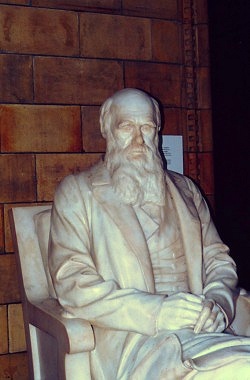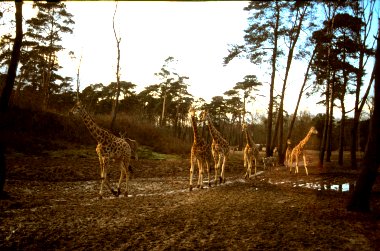

Giraffes in Burgers' Zoo in Arnhem (NL)
How did giraffes obtain their extremely long neck?
First the vison of Lamarck: He believed living creatures to change as a consequence of certain urges they have. In this way the ancestors of the giraffe (still having a short neck) had a desire to eat from leaves in the top of the trees. To reach these they constantly stretched their neck. This caused their neck to lengthen some millimeters during their lifetime. Lamarck believed that this acquired trait was passed on to the offspring. In other words: he believed that these kind of acquired characteristics became hereditary. If this process was going on for a great number of generations, a very long neck could come into existence.
This has been proved not to be correct (with a few exceptions, e.g. in bacteria). A professional tennis player can get an extended arm during his career, but his children will not inherit this trait.
Know more?
Lamarck
- Every species produces too many offspring. This causes overpopulation after some time. A 'struggle for life' is brought about by lack of space and food.
- Inside a population (a local group of the same species) is much variation. This means: there are many differences between the individuals. Only look around in your own species.
Some variations turn out to be favourable in the struggle for existence, other ones are neutral or (in most cases) negative. During a famine in the ancestral population of the giraffes it was probably favourable to have a relatively long neck, because the 'longnecks' had more possibilities to gather food for their young ones than the 'shortnecks'. They could raise up a larger offspring, they had more success in their propagation.
- If this trait is hereditary (and this is often the case), it is passed on to the next generation and thus the trait spreads itself over the population. As for the ancestors of the giraffe: the neck is getting slowly longer in the course of many generations and a 'longneck' comes into existence.
It is not known if this is really the way the giraffe got his long neck, for nobody has seen it happen. But the example serves to explain the principle of natural selection.
It will be clear that evolution mainly occurs when a population is in a difficult situation. The stronger the pressure, the faster the process of evolution. When the pressure is too high, the species becomes extinct.
This very important principle I shall explain again in the next pages using other examples.
Know more?
Natural
selection